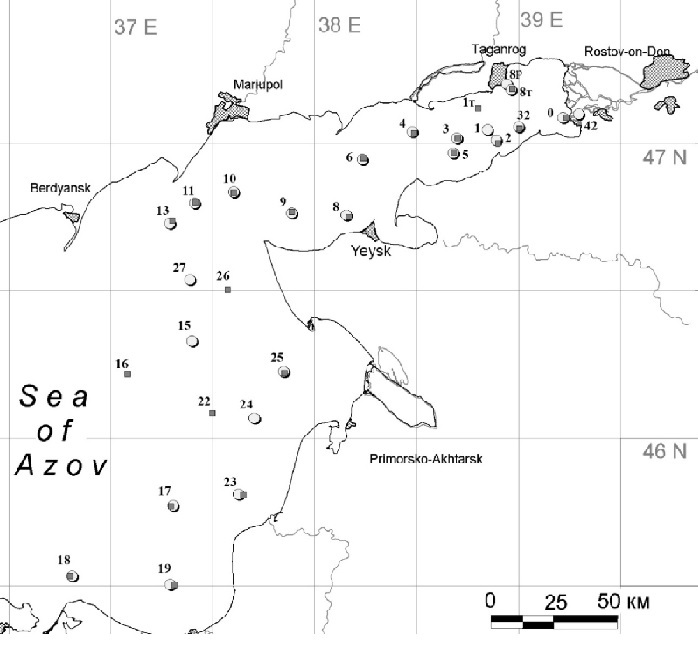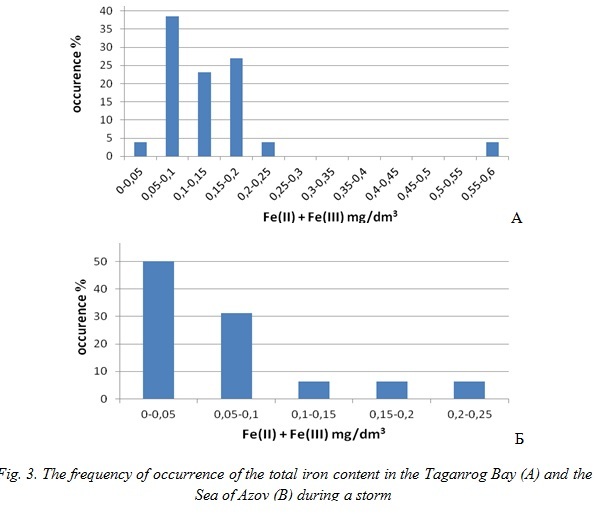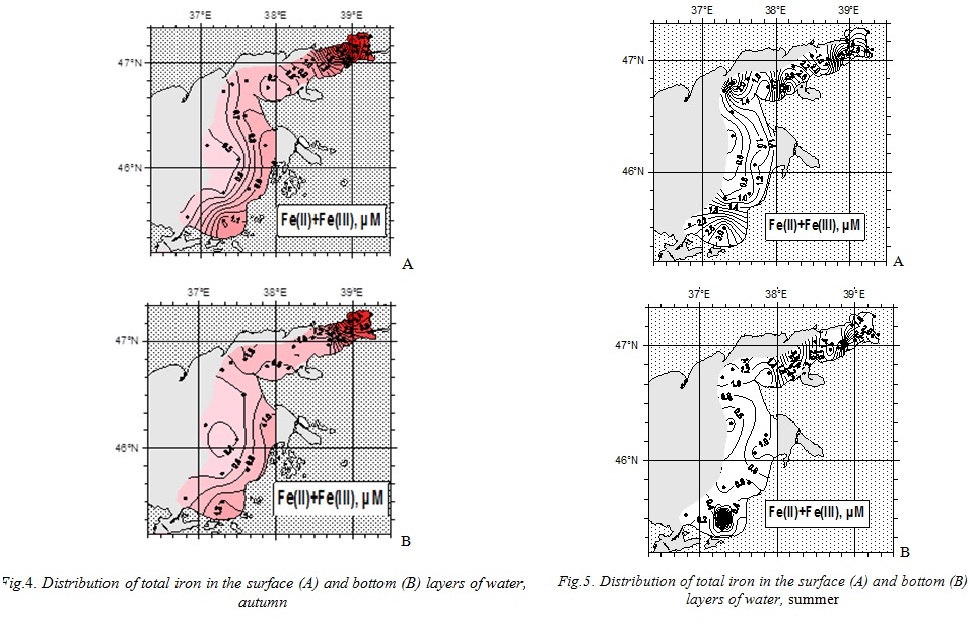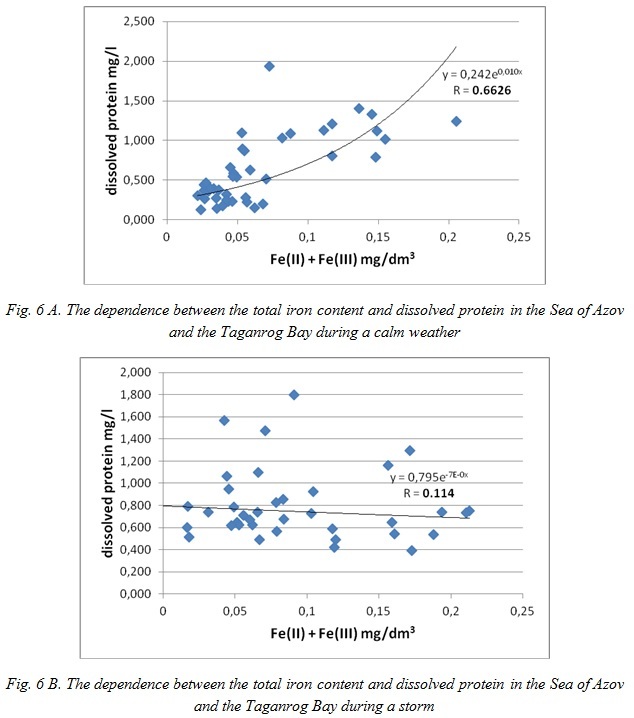BISAC NAT010000 Ecology
BISAC NAT045050 Ecosystems & Habitats / Coastal Regions & Shorelines
BISAC NAT025000 Ecosystems & Habitats / Oceans & Seas
BISAC NAT045030 Ecosystems & Habitats / Polar Regions
BISAC SCI081000 Earth Sciences / Hydrology
BISAC SCI092000 Global Warming & Climate Change
BISAC SCI020000 Life Sciences / Ecology
BISAC SCI039000 Life Sciences / Marine Biology
BISAC SOC053000 Regional Studies
BISAC TEC060000 Marine & Naval
The distribution and behavior of certain of trace elements in sea water is greatly affected by both physical, chemical and hydrometeorological conditions that are showed in the scientific works of prof. Yu.A. Fedorov with coauthors (1999-2015). Due to the shallow waters last factor is one of the dominant, during the different wind situation changes significantly the dynamics of water masses and interaction in the system “water – suspended matter – bottom sediments”.Therefore, the study of the behavior of the total iron in the water of the sea at different wind situation is relevant. The content of dissolved iron forms migration in The Sea of Azov water (open area) varies from 0.017 to 0.21 mg /dm3 (mean 0.053 mg /dm3) and in Taganrog Bay from 0.035 to 0.58 mg /dm3 (mean 0.11 mg /dm3) and it is not depending on weather conditions.The reduction in the overall iron concentration in the direction of the Taganrog Bay → The Sea of Azov (open area) is observed on average more than twice. The dissolved iron content exceeding TLV levels and their frequency of occurrence in the estuary, respectively, were higher compared with The Sea of Azov (open area).There is an increase in the overall iron concentration in the water of the Azov Sea on average 1.5 times during the storm conditions, due to the destruction of the structure of the upper layer and resuspension of bottom sediments, intensifying the transition of iron compounds in the solution.
The Sea of Azov, the Taganrog Bay, iron, wind activity
I. INTRODUCTION
Iron is one of the most common elements in nature, which is approximately 4% of the total mass of the earth's crust. As a result of chemical weathering of rocks the iron is in natural water in which it is migratory in three forms: dissolved, colloidal and suspended. Dissolved iron are in the water in ionic form (Fe2+ and Fe3+), in the form of hydroxocomplexes (Fe(OH)2, Fe(OH)3 etc.) and complex compounds with mineral and organic substances water. This element in addition to dissolved and suspended forms of migration may be present in the following conditions: colloids and pseudocolloid, simple and complex ions with a positive charge and the complex ions that carry a negative charge, and neutral complex molecules. To denote the total concentration of all dissolved forms of iron in water we used the term "total iron". The term "total concentration" or "total content" is used when talking about the total content in water as dissolved and suspended forms of iron [1]. Iron plays an important physiological and biochemical role in living organisms. Its hydroxides are active sorbents of heavy metals. This contributes to their co-deposition and removal of sediment in promoting self-purification of water. On the other hand, high concentrations of this element can have toxic effects on organisms. In [2] on the example of the distribution of suspended matter, methane, and sulfur isotopic composition of sulfate ions, and in communications [3-9] – organic matter of some priority heavy metals, values of Eh and pH, was demonstrated the important role of weather conditions in the change of these characteristics in shallow water in the Azov sea. The study of the distribution, modes of occurrence and migration of iron in surface and mine waters of the Azov seas basin were devoted to the work [10-12]. In the present communication will focus on the distribution of total dissolved iron in the water column of the Sea of Azov and his behavior in conditions of permanent changing wind situations.

Fig. 1. Map-scheme of location of sampling stations during expeditions in summer (○) and autumn (■)
II. Materials and methods
The study was conducted in the Taganrog Bay and in the Russian area of Azov Sea (Fig.1). During the expedition, samples were sampled in different weather conditions, methods of selection and identification of samples is presented in [4]. In the process, made 22 oceanographic stations (Fig.1). At each station held vertical exploring of temperature, salinity, О2, рН, Eh from surface to bottom by probe "Hydrolab". Samples were taken from two horizons from the surface and the bottom layers. In each sample held determining dissolved oxygen, ammonia, nitrite, nitrate nitrogen, phosphates, silica, organic forms of nitrogen and phosphorus, iron (Fe+2) and (Fe+2 + Fe+3), quantitative and qualitative composition (proteins, lipids, carbohydrates) dissolved and suspended organic matter [4,5].
III. Results and discussion
The values of total iron content in the Taganrog Bay of the fall in calm weather fluctuate from 0,035 mg/dm3 to 0,21 mg/dm3 (on the average 0,084 mg/dm3), and in the Sea of Azov - from 0,021 mg/dm3 to 0,07 mg/dm3 (on the average 0,04 mg/dm3). In the Taganrog Bay, concentrations varies from 0 to 0.05 mg/dm3 in 34.6% of samples, from 0,05 to 0,1 mg/dm3 – 30,8%, from 0,1 to 0,15 mg/dm3 – 26,9%, from 0,15 to 0,2 mg/dm3 – 3,85%, from 0,2 to 0,25 mg/dm3 – 3,85%. In the Sea of Azov (fig.2B) on the interval 0-0.05 mg/dm3 accounted 77.8% of all values, and the interval 0.05-0.1 mg/dm3 - 22.2%.
.jpg)
In summer, during a storm in the Taganrog Bay of the total iron content varies from 0.044 mg/dm3 to 0.58 mg/dm3 (on the average 0,13 mg/dm3). In the Sea of Azov content varies from 0,017 mg/dm3 to 0,21 mg/dm3 (on the average 0,067 mg/dm3). In the Taganrog Bay (Fig. 3 A) on the interval 0-0.05 m /dm3 falls 3.85%, at an interval of 0.05-0.1 mg / dm3 - 38.5%, in the range 0,1-0 15 mg/dm3 - 23.1% at the interval of 0.15-0.2 mg / dm3 - 26.9% at the interval of 0.2-0.25 mg/dm3 - 3.85%, on the interval 0,55-0,6 mg / dm3 - 3.8%. And in the Azov Sea (Fig. 3 B) on the interval 0-0.05 mg/dm3 accounted for 50%, in the range of 0.05-0.1 mg / dm3 - 31.25%, in the range 0,1-0, 15 mg/dm3 - 6.25%, at an interval of 0.15-0.2 mg/dm3 - 6.25% and the interval of 0.2-0.25 mg/dm3 - 6.25%.

In Taganrog Bay for the entire observation period of total iron content ranged from 0.035 mg/dm3 to 0.58 mg/dm3, on the average 0,11 mg/dm3, it is 2.5 times higher than the MPC for marine water bodies of fishery (0.05 mg/dm3). In the Sea of Azov total iron content ranged from 0,017 mg/dm3 to 0,21 mg/dm3, on the average 0,053 mg/dm3. The average content of Feобщ in the Taganrog Bay approximately 2-fold higher than in the Sea of Azov.
In the autumn iron concentrations was distributed in the Sea of Azov as follows: in the surface layer (Fig.4A) in the open sea of the metal content ranged from 0,5 to 1,1 μM (0,03 – 0,06 mg/dm3). In the estuary the concentration was changed from 0.7 to 2.8 μM (0,04 – 0,16 mg/dm3). The iron content in the bottom layer (Fig.4B) of the open part of the sea ranged from 0.4 to 1.2 μM (0,02 – 0,07 mg/dm3), in estuaries concentrations ranged from 0,8 to 3,4 μM (0,04 – 0,19 mg/dm3).
In summer on the surface (fig. 5A) iron content in the sea ranged from 0.6 to 3.0 µm (0.03 to 0.17 mg/dm3), in the Taganrog Bay of from 1.6 to 3.0 µm (0.09 to 0.17 mg/dm3) and in the bottom layer (Fig.5B) in the sea from 0.4 to 1.2 µm (0,02 – 0,07 mg/dm3), in the Taganrog Bay from 1.4 to 2.6 µm (0,08 – 0,15 mg/dm3). Thus, it was found that during calm weather a higher concentration of dissolved iron are characterized by near-bottom layers of water, whereas with increasing wind activity increased contents of this element are recorded in the surface layers of the water column.

In summer (Fig.5A) iron content in the surface layers of open part of sea ranged from 0.6 to 3.0 µm (0.03 to 0.17 mg/dm3). In the Taganrog Bay concentration of iron changed from 1.6 to 3.0 µm (0.09 to 0.17 mg/dm3). In the bottom layer (Fig.5B) content varied from 0.4 to 1.2 µm (0,02 – 0,07 mg/dm3), in the Taganrog Bay - from 1.4 to 2.6 µm (0,08 – 0,15 mg/dm3). Thus, it is determined that during calm weather a higher concentration of dissolved iron are characterized by near-bottom layers of water, whereas with increasing wind activity increased contents of this element are recorded in the surface layers of the water column of the sea.
We studied the change based on the content of dissolved protein from the dissolved iron (Fig.6A and B).

In calm weather (Fig.6A) there is a clear exponential relationship with a correlation coefficient of 0.66, while increasing wind activity, this dependence is disappear practically (Fig.6B).
IV. Conclusion
The study showed that the average content of total dissolved iron during the storm was 1.5 times higher as compared to those during a calm. Such an increase in the dissolved iron content may be due to his transition into the water column due to resuspension bottom sediments with increasing wind activity. During calm weather, the higher concentration of dissolved iron is observed in the bottom layer of water. During wind activity higher levels recorded in the surface water layer. Noteworthy is the fact that in calm weather between the content of dissolved protein and iron takes place a significant exponential relationship is direct, while in windy weather, it is almost absent. This may indicate the prevailing role of iron associated to organic and organic-mineral complexes in the period of quiet water. With increasing excitement of the water masses, they are more rapidly destroyed, which leads to the transition element into the water and reduce the closeness of the connection between these ingredients. The concentration of dissolved iron was higher in the Taganrog Bay than in the open part of the Sea of Azov irrespective of weather conditions that relate to the acquisition of iron from flowing into the Taganrog Bay of the rivers.
V. ACKNOWLEDGMENT
The work was supported by project №5.1848.2014/К
1. Yu. A. Fedorov, L. M. Predeina, L. Yu. Dmitrik Iron: distribution, forms of occurrence and migration in surface and mine waters of the Eastern Donbass and the Sea of Azov // Proceedings of the VII International scientific-practical conference "Ecological problems. A look into the future". Rostov-on-don: Publishing southern Federal University, 2015, P. 332-336.
2. Yu.A. Fedorov Stable isotopes and evolution of the hydrosphere. - Moscow: MO RF CENTER Istina, 1999, 370 p.
3. Yu.A. Fedorov, I.V. Dotsenko, A.N. Kuznetsov, A.A. Belov, E.A. Loginov, Regularities of Organic Carbon Distribution in Bottom Sediments of the Russian Part of the Sea of Azov. Oceanology. 2009, vol. 49, No 2, p. 211 - 217
4. Yu.A. Fedorov, V.V. Sapozhnikov, A.I. Agatova, N.V. Arzhanov, A.A. Belov, A.N. Kuznetsov, N.M. Lapina, E.B. Loginov, L.M. Predeina, T.B. Semochkina, N.I. Torgunova Comprehensive ecosystem studies in the Russian part of the Sea of Azov (18-25 July 2006) // Oceanology, 2007, vol.47, No. 2, pp. 316-319.
5. Yu.A. Fedorov, I.V. Dotsenko, A.V. Mikhailenko Mercury and organic matter in bottom sediments in the profile Don river − Sea of Azov // Conference Proceedings of 14-th International Multidisciplinary Scientific GeoConference &EXPO Modern Management of Mine Producing, Geology and Environmental Protection, SGEM 2014. Bulgaria, 2014, Vol.II, pp. 717-723
6. Yu.A. Fedorov, I.V. Dotsenko, A.V. Mikhailenko Regular patterns of distribution and behavior of trace elements in aquatic landscapes along the continuum of «the mouth of the Don River − Sea of Azov» // Conference Proceedings of 15th International Multidisciplinary Scientific GeoConference, SGEM 2015. Bulgaria, 2015, vol. I, pp.721-726.
7. Yu.A. Fedorov, I.V. Dotsenko, A.V. Mikhailenko The role of the hydrological factors in the formation of field concentrations and fluxes of reduced gases and mercury in the Sea of Azov // Conference Proceedings of 11-th International Multidisciplinary Scientific GeoConference&EXPO Modern Management of Mine Producing, Geology and Environmental Protection, SGEM 2011. Bulgaria, 2011, Vol.III, pp. 717-723.
8. A.A. Zimovets, Yu.A. Fedorov, A.E. Ovsepyan, A.V. Mikhailenko, I.V. Dotsenko About the features of the mercury levels formation in precipitation of the Azov Sea and White Sea // Conference Proceedings of 15th International Multidisciplinary Scientific GeoConference, SGEM 2015. Bulgaria, 2015, vol. I, pp.19-24.
9. Yu.A. Fedorov, I.V. Dotsenko, A.V. Mikhailenko Behavior of heavy metals in water of the Azov sea during wind activity // Izvestiya vuzov Severo-Kavkazskiy region. Natural science. No. 3. Rostov-on-don, 2015, p. 108 - 112.
10. L.Yu. Dmitrik, Yu.A. Fedorov The levels and distribution of iron on geochemical barriers in the system "mine water - river - pond" // Actual problems of Earth Sciences. Proceedings of the scientific conference of students and young scientists with international participation; southern Federal University. Rostov-on-don: Publishing southern Federal University, 2015, 518 p.
11. Yu.A. Fedorov, Y. L. Dmitrik Behavior of iron in the system "Mine water-river-sea of Azov" // Topical issues of modern physics, mathematics and natural Sciences: proceedings of the international scientific e-Symposium. Russia, Moscow, June 29-30, 2015 [Electronic resource] / under the editorship of Professor Yu. a. Fedorov. - Electron.text. Dan. (1 file is 5.6 MB). Kirov: MCNIP, 2015, p. 145-151.
12. Yu.A. Fedorov, L.Yu. Dmitrik, M.P. Galushko Behavior of iron on geochemical barriers in the system "Mine water-river-pond" // Materials of scientific conference with international participation "Modern problems of hydrochemical monitoring of surface water quality". Part 1. Rostov-on-don, 2015, p. 175-178.







